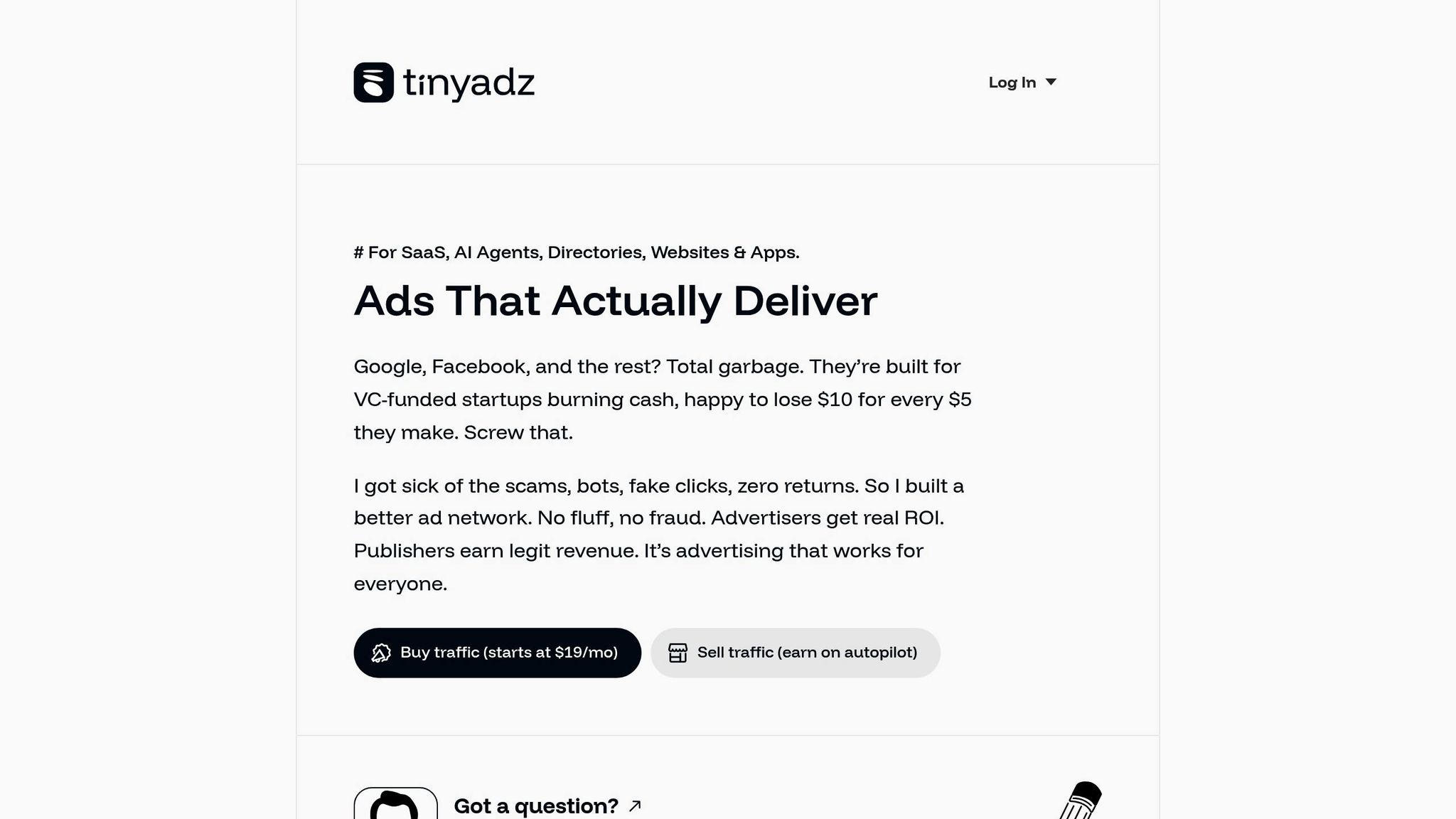Want to buy a high-traffic website? Here's the quick guide you need:
- What is a high-traffic website? A site with lots of daily visitors. But it’s not just about numbers - engagement, bounce rates, and traffic sources matter more than raw visits.
- Why buy one? You get instant access to an audience, ready revenue streams like ads or affiliate programs, SEO advantages (think better Google rankings), and quicker market expansion.
- How to evaluate? Look for genuine traffic (not bots), steady growth, and diverse revenue streams. Use tools like Google Analytics, SimilarWeb, or Ahrefs to verify traffic and income claims.
- Where to buy? Check platforms like Flippa, Empire Flippers, or Motion Invest. Or explore niche groups and direct outreach.
- How to monetize? Optimize ads, subscriptions, or affiliate marketing. Platforms like TinyAdz can help boost ad revenue.
Quick Tip: Always verify traffic authenticity and revenue before buying. Avoid fake stats and focus on websites that align with your business goals.
SEO Niche Finder Tool - Find low DR, high traffic sites in 30 seconds
How to Evaluate High-Traffic Websites Before Buying
Buying a high-traffic website without proper research is like purchasing a car without inspecting the engine. Sure, the numbers might look great, but you need to dig deeper to uncover the true value. The quality of traffic matters far more than just the volume, and revenue potential depends on much more than visitor counts.
Checking Traffic Quality and Real Numbers
Sometimes, sellers inflate their traffic stats using bots, cheap traffic sources, or shady exchange schemes. To make a smart investment, you need to focus on genuine, human visitors and spot any signs of fake traffic early on.
Start by analyzing the traffic graph. Look for steady, organic growth. Sudden spikes, sharp drops, or unusual traffic patterns - like a large influx from a single region - can signal bogus traffic. Legitimate websites tend to show gradual increases with natural fluctuations tied to seasonal trends, new content, or marketing efforts.
Next, examine traffic sources. A healthy website usually has a balanced mix of search engine traffic, social media referrals, direct visits, and other sources. If an unusually high percentage of traffic comes from one source (e.g., 80% direct visits or low-quality referrals), it’s worth investigating further. Tools like Google Analytics can help identify non-human activity, such as short session durations, an unusually high percentage of new visitors from a single location, or traffic spikes from regions unrelated to the site's content.
To confirm the seller’s data, use third-party tools like SimilarWeb, Ahrefs, SEMrush, or Serpstat. If these tools show significant discrepancies compared to the seller’s analytics, consider it a red flag. Also, request a live, screen-shared walkthrough of the analytics instead of relying on screenshots or exported reports.
Revenue Sources and How Sites Make Money
Once you’ve verified the traffic is real, shift your focus to how the site generates revenue. Common models include advertising, subscriptions, affiliate marketing, and direct sales.
Advertising is one of the most popular revenue streams. For example, digital display ad spending is projected to hit $175.6 billion by 2025, according to eMarketer. However, ad revenue can be unpredictable, as it depends on traffic quality, seasonal trends, and broader industry shifts.
Subscription models, on the other hand, provide a more stable income stream - especially for sites offering exclusive content, tools, or services. Affiliate marketing works best when the products being promoted align well with the site's audience. Direct sales can also be lucrative, cutting out middlemen and increasing profit margins.
Here’s a real-world example: A news portal in Central Europe boosted its revenue by 70% in just six months by optimizing ad placements and pricing strategies without adding more ad slots. As Murager Sharipov, Department Head of Ad Monetization at Netpeak Agency, puts it:
"Traffic monetization is the process of converting website or app traffic into revenue through various strategies."
Diversifying revenue streams is key to reducing risks and ensuring long-term profitability. Platforms like TinyAdz can help maximize earnings by providing additional advertising opportunities and optimization tools.
Matching the Website to Your Business Goals
After confirming traffic authenticity and revenue potential, the next step is to ensure the website aligns with your business goals. Start by analyzing the audience demographics using tools like Google Analytics or social media insights. Look at factors such as age, location, interests, and browsing habits, and compare these with your ideal customer profile.
The website’s content also needs to match your brand’s message. For example, if your business focuses on luxury travel, a site centered on budget travel tips may not be the right fit. Make sure the content aligns with your target audience.
Engagement metrics can provide additional insights. High bounce rates, short time on page, or low social sharing might indicate that visitors aren’t finding what they’re looking for. On the flip side, strong engagement signals a genuinely interested audience. Studies show that 80% of customers are more likely to buy from brands that offer personalized experiences.
Finally, conduct a competitive analysis to see how the website’s positioning stacks up against market demand. Even high traffic numbers won’t matter if the audience isn’t likely to convert into customers. By evaluating these factors, you can confidently invest in a website that supports your business goals.
Where to Find High-Traffic Websites for Sale
Looking to buy a high-traffic website? You're in luck - there are plenty of platforms and strategies to help you find the right one. From large, public marketplaces to exclusive, membership-based communities, the options are diverse. Below, we'll explore some trusted marketplaces and tools to help you secure a site that meets your needs.
Best Places to Buy High-Traffic Websites
Flippa
Flippa is one of the largest digital asset marketplaces, with 600,000 global buyers and 17,000 new buyers joining monthly. It offers a wide range of assets, including SaaS products, eCommerce stores, blogs, and online communities. Pricing starts at $29 for the Entry Level Package, with success fees beginning at 3%. However, listings aren't pre-vetted, so you'll need to do your own due diligence. Use filters to narrow your search, check listings often, and act fast.
Empire Flippers
Empire Flippers stands out for its vetting process, which verifies traffic and profit data. Most deals here are priced at $100,000 or higher, making it a great option for serious investors. The platform charges sellers a 15% broker fee. As TheWebsiteFlip.com puts it:
"If you are looking to buy or sell a content website, e-commerce, Amazon FBA, SaaS, or any other online business, Empire Flippers is highly recommended."
Investors Club
This membership-based platform offers vetted deal flow and due diligence reports. Sellers pay a 5% broker fee, while buyers pay a membership fee for access. In 2020, entrepreneur Mushfiq Sarker purchased two websites through Investors Club, each costing $22,000.
Motion Invest
If you're looking for content sites under $30,000, Motion Invest is worth checking out. They use a Dutch-auction model to sell sites. Another option is The Website Flip Brokerage, a boutique service that sells vetted content sites primarily through its newsletter.
For higher-revenue businesses, consider specialized brokers like FE International, Latona's, and Quiet Light Brokerage, which focus on mid-market assets with strong revenue streams.
Facebook Groups
Communities like Niche Website Flippers and Flipping Websites can also be great resources. However, always use escrow services and verify all claims independently when buying through Facebook groups.
Manual Outreach
Reaching out to website owners on later Google search pages can sometimes uncover opportunities for improvement and acquisition.
TinyAdz
This platform connects buyers with verified niche publishers, offering another avenue to explore.
Whichever platform you choose, make sure the site's traffic and revenue data align with the claims made by sellers.
Tools to Verify Traffic and Website Data
Once you've shortlisted potential websites, it's crucial to verify their traffic and performance. Here are some trusted tools to help you do just that:
- SimilarWeb: According to a SparkToro study, SimilarWeb provides some of the most accurate traffic estimates, closely matching Google Analytics data for sites with 5,000 to 100,000 monthly users. Plans start at $149 per month, with professional options at $399 per month.
- Semrush: Offers detailed traffic analytics, including estimated visits, traffic sources, and geographic data. Plans range from $119.95 to $449.95 per month, with a free version offering limited features.
- Ahrefs: Known for its comprehensive SEO tools, Ahrefs also provides traffic analysis. Pricing starts at $99 and goes up to $999 per month.
- Sitechecker: A budget-friendly option for traffic verification, with plans ranging from $23 to $499 per month.
- Serpstat: Offers a free plan with limited features, while paid plans range from $48 to $349 per month.
- Ubersuggest: A beginner-friendly tool for traffic data, with pricing from $29 to $99 per month and a free plan available.
When verifying traffic, focus on metrics like traffic volume, sources, page views, session duration, bounce rate, conversion rate, unique visits, and exit pages. Cross-referencing data from multiple tools can help you get a more accurate picture.
For the most reliable data, Google Analytics is the gold standard - if the seller grants access. It provides precise visitor data directly from the source. Additionally, Google Search Console offers insights into organic search performance, making it a valuable complement.
sbb-itb-957fd63
How to Negotiate and Buy the Website
After completing your due diligence, the next step is negotiating the purchase and securing ownership of the website. This involves determining a fair price, agreeing on terms that satisfy both parties, and managing the legal and technical aspects of transferring ownership.
How to Calculate the Right Purchase Price
Calculating a fair price is key, and industry-standard valuation methods can guide you. Bill Widmer, a website valuation expert, explains:
"The value of your website comes down to three things: The income you generate (and where that income comes from), Your website's traffic (and the quality of that traffic), Additional added value (e.g., backlink profile, social media audience, or email list)."
Revenue Multiple Method
Websites are typically valued at 30–45 times their monthly net profit. For instance, a site earning $5,000 in monthly net profit could sell for somewhere between $150,000 and $225,000.
Over the years, the average sales multiple for content sites has increased, from 27.6 in 2018 to 31.6 in 2020.
What Drives Higher Valuations
Websites with high-quality organic traffic and diverse income streams are more attractive to buyers, often commanding higher multiples. Other factors, like a strong domain rating, quality backlinks, a large email list, and active social media accounts, can also boost the overall valuation.
Steps to Practical Valuation
Start by creating a financial spreadsheet to calculate net profit, factoring in revenue, expenses, and any add-backs (expenses a new owner wouldn't incur, like one-time costs or owner salaries). For businesses with annual revenue under $5 million, use Seller Discretionary Earnings (SDE). Larger businesses typically rely on EBITDA. Comparing this against a multiple range of 20x–60x+ can help you spot undervalued opportunities.
Once the price is clear, you’re ready to move on to negotiations.
Negotiation Strategies
According to Empire Flippers, most listings sell within 10% of their asking price. However, there’s often room to negotiate, especially for newer websites (less than six months old) that carry higher risks, like vulnerability to Google algorithm updates.
If the seller is firm on price, consider negotiating for added perks, such as training or asset transfers. Many experts highlight the value of training and support, which can sometimes outweigh a small price reduction.
Legal and Technical Steps for Ownership Transfer
After agreeing on a price, the focus shifts to the legal and technical aspects of the transfer.
Legal Requirements
Your purchase agreement should clearly outline what’s included in the sale - domain names, website content, social media accounts, email lists, and any proprietary tools or software. Ensure the seller has the rights to all content and intellectual property. To protect yourself, consider structuring part of the payment as an earn-out, where future payments depend on the website’s performance.
Technical Transfer Process
- Domain Transfer: Unlock the domain and request its authorization (EPP) code. ICANN requires a 60-day lock after changes to registrant information, though some registrars allow opt-outs. Transferring the domain registration won’t affect your website’s content or email settings.
- Hosting Account Access: The seller should provide access to the hosting account and update contact details (name, email, and billing info). Once you have control, secure the account by changing the password.
- Third-Party Tools: Gain access to all third-party services tied to the website, such as Google Analytics, Google Search Console, and monetization platforms. Update credentials and contact information as needed.
- File Transfer: Request all related files, including logos, custom icons, style guides, and other assets not stored on the hosting account.
- Account Verification: Confirm that everything is functioning as expected - analytics should track properly, monetization channels should remain active, and the website should operate smoothly.
The technical transfer can take one to two weeks, depending on the website’s complexity and the number of third-party integrations. Planning for this timeline during negotiations will help ensure a seamless transition.
How to Make Money from Your New Website
Turning your website into a revenue-generating machine starts with smart strategies that align with your niche and audience. Here's how to make it happen.
Adding the Website to Your Business Operations
When you acquire a high-traffic website, the first step is to integrate it into your business plan. This means aligning its technical setup and revenue strategies with your broader goals. Once you've set up monetization and ensured the site runs smoothly, keep an eye on performance metrics to maintain and grow revenue.
Start with Technical Optimization
Before diving into monetization, make sure your website is technically sound. A fast-loading, mobile-friendly website is essential for both user experience and revenue potential. Also, optimizing your content for search engines is crucial for maintaining organic traffic.
Speed plays a huge role in user behavior. For instance, if your page load time increases from one second to three, the chances of a visitor leaving jump by 32%. Even a one-second delay can hurt page views, customer satisfaction, and conversions. For business-to-business sites, faster-loading pages (around one second) can convert three times better than slower ones.
Build a Strong Revenue System
Once the technical side is solid, focus on creating multiple streams of income. Email marketing tools like Mailchimp can help you stay connected with your audience. Email lists are incredibly valuable for long-term monetization.
Take inspiration from companies like BuzzFeed and Spotify. BuzzFeed uses a mix of ad networks, affiliate marketing (like Amazon links), and sponsored content to cater to its audience. Meanwhile, Spotify combines free, ad-supported accounts with premium subscriptions and sponsored content to build a diversified revenue model.
Using TinyAdz to Increase Revenue

TinyAdz offers a range of tools to help you maximize your website's revenue. Its platform allows publishers to display ads tailored to their audience while maintaining a positive user experience.
Flexible Monetization Options
TinyAdz provides several ways to monetize your site, including banner ads, directory monetization, social media monetization, newsletter revenue, and event monetization. For example, you can use banner ads to fill unused spaces on your site without disrupting the user experience. However, avoid overloading your site with ads, as that could drive visitors away.
If your site includes directories, you can turn these into revenue opportunities by monetizing informational pages.
Transparency and Quality
One of TinyAdz's strengths is its focus on quality traffic and clear reporting. The platform provides detailed insights into ad performance, making it easier to fine-tune your monetization efforts.
Strategic Ad Placement
To get the most out of TinyAdz, experiment with different ad formats and placements to see what works best. The platform also uses personalized matchmaking to connect publishers with the right advertisers, ensuring that ads are relevant to your audience. You can even monetize newsletters and social media channels to tap into additional revenue streams.
Tracking and Improving Website Performance
To keep your website profitable, continuous monitoring and optimization are key. Regularly check your site's speed, responsiveness, and overall performance, as these directly impact user experience and revenue generation.
Key Performance Metrics
Focus on metrics that influence revenue. These include Core Web Vitals like Largest Contentful Paint (LCP), Interaction to Next Paint (INP), and Cumulative Layout Shift (CLS). Additionally, track real-time metrics like page load time, error rates, and network latency.
| Metric | Good | Needs Improvement | Poor |
|---|---|---|---|
| LCP (Largest Contentful Paint) | ≤2.5s | ≤4s | >4s |
| INP (Interaction to Next Paint) | ≤200ms | ≤500ms | >500ms |
| CLS (Cumulative Layout Shift) | ≤0.1 | ≤0.25 | >0.25 |
Revenue-Centric Analytics
Beyond technical metrics, monitor revenue-focused indicators. Start with a basic analysis of traffic, SEO, page speed, and mobile responsiveness. Then, dig deeper into user behavior to understand what attracts visitors, what obstacles they face, and what drives them to take action.
Continuous Improvement
Use tools to track real-time user experiences and identify issues like slowdowns or errors. Set up alerts to quickly address problems and keep your site running smoothly.
Optimization efforts can have a big payoff. For example, Spotify reduced its email bounce rate from 12.3% to 2.1% in just 60 days by using a new Email Verification API. This project, led by Sarah Chen, Spotify's Email Marketing Manager, involved cleaning a 45-million subscriber database and implementing real-time verification. The result? A 34% boost in deliverability and $2.3M in additional revenue.
Keep Refining Your Approach
Improving website performance is an ongoing process. Summarize your findings, set clear goals, and outline the steps needed to achieve them.
"80-90% of the end-user response time is spent on the front end. Start there."
There's no one-size-fits-all approach to monetization. Test different strategies, analyze the results, and adjust based on what resonates with your audience. With the right tactics and consistent monitoring, your website can become a reliable source of income for years to come.
Conclusion: Main Points to Remember
Acquiring a high-traffic website can be a game-changer for your business. The key is staying objective during the evaluation process, even if you're passionate about a particular niche.
Start with thorough due diligence - dig into the website's background, analyze data trends, and verify all critical metrics. Pay close attention to niche relevance, traffic consistency, financial performance, and daily operations. Double-check income statements to ensure they're accurate and align with your expertise. It's often wiser to prioritize websites with a steady, proven income rather than those promising unverified growth. Also, consider the time investment required, especially when financials are based on Seller Discretionary Earnings (SDE), which is a common valuation model. This detailed assessment lays the groundwork for a successful acquisition.
After completing due diligence, shift your focus to monetization strategies. Partnering with a platform like TinyAdz can help you maximize revenue through high-value campaigns, genuine human impressions, and flexible options such as banner ads, directory monetization, social media monetization, and newsletter revenue.
Finally, remember that technical optimization and diversified revenue streams are essential for long-term success. Regularly optimize your site for speed, mobile usability, and multiple income sources, while keeping an eye on key performance metrics. With consistent effort, your high-traffic website can turn into a profitable, sustainable investment.
FAQs
How can I verify that a website’s traffic data is accurate and not artificially inflated?
To make sure a website's traffic data is reliable, begin by examining its analytics for any odd trends. Look out for high bounce rates, very short session times, or sudden traffic spikes that don't make sense. These could be signs of artificial or manipulated traffic.
It’s also important to analyze traffic sources closely. A sudden influx from unknown IP addresses or unusual geographic locations can be a warning sign. Use trusted analytics tools to identify bot activity and track traffic patterns over time. Keep an eye out for irregular or overly consistent patterns, as both can hint at tampering.
For extra peace of mind, cross-reference the data with third-party verification tools designed to spot fake traffic. And don’t forget - always request access to the website's detailed analytics from the seller to confirm the numbers before committing to any purchase.
What should I consider to ensure a high-traffic website fits my business goals?
To make sure a high-traffic website matches your business goals, start by assessing how well it fits your niche and whether its purpose aligns with what you're trying to achieve. Then, dive into important metrics like page views, unique visitors, and engagement rates to ensure the traffic is high-quality and relevant.
You’ll also want to take a closer look at the website’s content, design, and SEO strategies to see if they appeal to your target audience. Check that the site’s authority and reputation are in line with your brand values, and confirm the traffic is legitimate to steer clear of scams or fake data. These steps will help you make a thoughtful and informed choice.
How can I integrate and monetize a high-traffic website after purchasing it for my business?
To make the most of a newly acquired high-traffic website, start by conducting a deep dive into its current performance. Analyze traffic sources, audience behavior, and existing revenue streams. This will give you a clear understanding of what’s working and where there’s room to grow. If a website migration is part of the plan, be sure to implement proper redirects to preserve SEO rankings and avoid losing valuable traffic.
When it comes to monetization, stick to strategies that have a proven track record. These include display ads, affiliate marketing, and direct ad sales. You can also branch out into additional revenue streams, such as sponsored content, paid memberships, or even offering new services tailored to the audience’s needs. Focus your monetization efforts on the site’s high-traffic pages to get the best return on investment.
Lastly, align all integrations and operations with U.S. standards. Use the dollar symbol ($) for currency, follow the MM/DD/YYYY date format, and consider cultural preferences to ensure a smooth and familiar experience for your audience. This attention to detail can help optimize revenue and boost user satisfaction.


